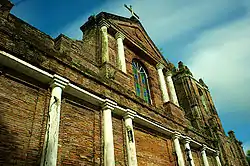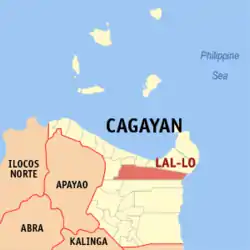Lal-lo
Lal-lo, officially the Municipality of Lal-Lo (Ibanag: Ili nat Lal-lo; Ilocano: Ili ti Lal-lo; Tagalog: Bayan ng Lal-lo), is a 1st class municipality in the province of Cagayan, Philippines. According to the 2015 census, it has a population of 44,506 people. [3]
Lal-lo
Nueva Segovia | |
|---|---|
| Municipality of Lal-Lo | |
 Nueva Segovia Church | |
 Seal | |
 Map of Cagayan with Lal-lo highlighted | |
OpenStreetMap 
| |
.svg.png.webp) Lal-lo Location within the Philippines | |
| Coordinates: 18°12′N 121°40′E | |
| Country | |
| Region | Cagayan Valley (Region II) |
| Province | Cagayan |
| District | 1st District |
| Barangays | 35 (see Barangays) |
| Government | |
| • Type | Sangguniang Bayan |
| • Mayor | Florence Oliver B. Pascual |
| • Vice Mayor | Maria Olivia B. Pascual |
| • Representative | Ramon C. Nolasco Jr. |
| • Electorate | 28,250 voters (2019) |
| Area | |
| • Total | 702.80 km2 (271.35 sq mi) |
| Elevation | 21 m (69 ft) |
| Population | |
| • Total | 44,506 |
| • Density | 63/km2 (160/sq mi) |
| • Households | 10,143 |
| Economy | |
| • Income class | 1st municipal income class |
| • Poverty incidence | 11.09% (2015)[4] |
| • Revenue | ₱182,466,322.96 (2016) |
| Time zone | UTC+8 (PST) |
| ZIP code | 3509 |
| PSGC | |
| IDD : area code | +63 (0)78 |
| Climate type | tropical monsoon climate |
| Native languages | Ilocano Ibanag Cagayan Agta language Tagalog |
During the Spanish colonial period, Lal-lo was known as Ciudad de Nueva Segovia and was the seat of the Diocese of Nueva Segovia before it was moved to Vigan in Ilocos Sur. It is currently under efforts to regain its Spanish-era city status.
Recently, the provincial government of Cagayan through the leadership of Governor Manuel Mamba is planning to make Lal-lo the provincial capital of Cagayan again.[5]
An international airport is currently being built in the southern part of Lal-lo. The Northern Cagayan International Airport is constructed to support the Cagayan Special Economic Zone in northern Cagayan and will also serve the seaborne traffic through Port Irene. The airport project involves the construction of a 2,200-meter runway, with a width of 45 meters, following the standards of the International Civil Aviation Organization. Once completed, the international airport can accommodate large aircraft such as the Airbus A319-100 and Boeing regional jets of comparable size.
Royal Air Philippines do twice weekly service using BAe146 aircraft.
Barangays
Lal-lo is politically subdivided into 35 barangays.
- Abagao
- Alaguia
- Bagumbayan
- Bangag
- Bical
- Bicud
- Binag
- Cabayabasan (Capacuan)
- Cagoran
- Cambong
- Catayauan
- Catugan
- Centro (Poblacion)
- Cullit
- Dagupan
- Dalaya
- Fabrica
- Fusina
- Jurisdiction
- Lalafugan
- Logac
- Magallungon (Santa Teresa)
- Magapit
- Malanao
- Maxingal
- Naguilian
- Paranum
- Rosario
- San Antonio (Lafu)
- San Jose
- San Juan
- San Lorenzo
- San Mariano
- Santa Maria
- Tucalana
Etymology
Lal-lo means "twisting two strands to make a rope", or may also refer to the strong river current as it is located along Cagayan River, the longest and largest river in the Philippines.
History
Classical Era
In the classical era, Lal-lo was used to be the home of hunter-gatherers who were specialized in hunting mollusks. These hunter-gatherers have stockpiled their leftover mollusk shells in numerous sites in Lal-lo and neighboring Gattaran, until eventually, the shells formed into the largest stock of shell-midden sites in the entire Philippines.
Spanish Era
The first European to set foot on what is now the town of Lal-lo is Juan de Salcedo, the Spanish conquistador and grandson of Miguel Lopez de Legazpi, in 1572. Don Juan Pablo Carrion established it as a pueblo (municipality) in 1581 and named it Nueva Segovia. The reason is currently unknown, as the hometown of this Spanish soldier was Carrión de los Condes (Palencia, Spain), as his last name, Carrión, suggests. This is mentioned by Juan Miguel Aguilera and Ángel Miranda in their book "Espadas del Fin del Mundo" (2016).
Diocese of Nueva Segovia

In 1595, Pope Clement VIII created the Diocese of Nueva Segovia and in 1596, the Dominicans accepted it as an ecclesiastical mission. Nueva Segovia had three churches: the cathedral that was under the secular clergy, and the parishes of Centro and Tocolona under the supervision of the Dominicans. But because of its distance from Manila and the constant threat of the Cagayan River's rampaging waters, the Diocese of Nueva Segovia was transferred to Vigan in Ilocos Sur province in 1758. The diocese's name went along with the transfer to Vigan and to avoid confusion, Bishop Miguel Garcia requested that Nueva Segovia and its suburbs renamed back to Lal-lo. The seat of the Diocese of Nueva Segovia remains in Vigan till today where is now elevated as the Archdiocese of Nueva Segovia.
The transfer affected the closure of the cathedral and the merging of the three churches into the single parish of Centro. The two other churches were abandoned and eventually destroyed because of neglect while the church of Centro, dedicated to Santo Domingo de Guzman (Saint Dominic) became what is now the church of Lal-lo. The remains of three bishops are interred in the church: Bishop Miguel de Benavides who was Nueva Segovia's first bishop and later of Manila where he founded the University of Santo Tomas, Bishop Diego de Soria who was the second bishop of the diocese, and Bishop Diego Aduarte who was the sixth.
Provincial capital
Lal-lo used to be the capital of Cagayan province until 1839 when the provincial seat of power was relocated to Tuguegarao. The decline of Lal-lo is the transformation of Tuguegarao as the most important town in Cagayan. It was accepted as an ecclesiastical mission by the Dominicans in 1604, 23 years after the foundation of Lal-lo.
Restoration of Cityhood
The first attempt of the restoration of Lal-lo's city status was made during the first term of Mayor Florante Pascual. The historical document originally signed by King Philip was not found, even after sending a research delegation to Madrid. Pascual determined that the restoration of Lal-lo's cityhood be made through an earlier bill.[6]
There was a move in the Philippine Congress to regain its cityhood as a component city, and also rename the municipality back to its original name, Nueva Segovia.[7]
Renewed attempt of city status restoration was carried out in January 2012. Board member Maria Olivia Pascual said that researchers had found a Spanish document that declared the municipality as a city. According to her, a bill seeking the restoration of the city status of Lal-lo (the former Ciudad Nueva Segovia) might be filed again through the efforts of First District Representative Juan Ponce Enrile, Jr..[6]
As recently as 2018, vice mayor Oliver Pascual has said that the establishment of Northern Cagayan International Airport in the municipality would be "a great boost" in its bid for the restoration of its city status.[5]
Modern Era of Harvey Deseo
In 2006, the shell-midden sites of Lal-lo and Gattaran were included in the UNESCO Tentative List for World Heritage Site inclusion, a step closer to becoming a world heritage site. The shell-midden sites are currently being conserved by the local government from looting to preserve its outstanding universal value.
Demographics
| Year | Pop. | ±% p.a. |
|---|---|---|
| 1903 | 7,309 | — |
| 1918 | 9,385 | +1.68% |
| 1939 | 12,921 | +1.53% |
| 1948 | 10,730 | −2.04% |
| 1960 | 16,834 | +3.82% |
| 1970 | 21,400 | +2.43% |
| 1975 | 24,866 | +3.06% |
| 1980 | 26,947 | +1.62% |
| 1990 | 31,373 | +1.53% |
| 1995 | 32,156 | +0.46% |
| 2000 | 36,529 | +2.77% |
| 2007 | 39,607 | +1.12% |
| 2010 | 41,388 | +1.61% |
| 2015 | 44,506 | +1.39% |
| Source: Philippine Statistics Authority [3] [8] [9][10] | ||
In the 2015 census, the population of Lal-lo, Cagayan, was 44,506 people, [3] with a density of 63 inhabitants per square kilometre or 160 inhabitants per square mile.
Climate
| Climate data for Lal-lo, Cagayan | |||||||||||||
|---|---|---|---|---|---|---|---|---|---|---|---|---|---|
| Month | Jan | Feb | Mar | Apr | May | Jun | Jul | Aug | Sep | Oct | Nov | Dec | Year |
| Average high °C (°F) | 25 (77) |
26 (79) |
29 (84) |
31 (88) |
31 (88) |
31 (88) |
30 (86) |
30 (86) |
30 (86) |
28 (82) |
27 (81) |
25 (77) |
29 (84) |
| Average low °C (°F) | 20 (68) |
20 (68) |
21 (70) |
23 (73) |
24 (75) |
25 (77) |
25 (77) |
25 (77) |
24 (75) |
23 (73) |
23 (73) |
21 (70) |
23 (73) |
| Average precipitation mm (inches) | 120 (4.7) |
77 (3.0) |
62 (2.4) |
40 (1.6) |
118 (4.6) |
138 (5.4) |
162 (6.4) |
173 (6.8) |
143 (5.6) |
198 (7.8) |
185 (7.3) |
248 (9.8) |
1,664 (65.4) |
| Average rainy days | 16.9 | 12.2 | 11.5 | 10.6 | 18.7 | 20.1 | 21.2 | 23.3 | 20.8 | 16.9 | 16.5 | 20.0 | 208.7 |
| Source: Meteoblue [11] | |||||||||||||
Education
- Lal-lo National High School
- Cagayan State University (Lal-lo Campus)
- Lyceum of Lal-lo
- Lal-lo National High School - Cabayabasan Annex
- Logac National High School
- Magapit National High School
References
- Municipality of Lal-Lo | (DILG)
- "Province: Cagayan". PSGC Interactive. Quezon City, Philippines: Philippine Statistics Authority. Retrieved 12 November 2016.
- Census of Population (2015). "Region II (Cagayan Valley)". Total Population by Province, City, Municipality and Barangay. PSA. Retrieved 20 June 2016.
- "PSA releases the 2015 Municipal and City Level Poverty Estimates". Quezon City, Philippines. Retrieved 1 January 2020.
- Mapa, Susan (7 March 2018). "Cityhood ng Lal-lo, May Alas Na!". RMN Networks - Reaching Millions Nationwide. Retrieved 19 June 2019.
- De Yro, Benjie S. (January 30, 2012). "Document to back Lal-lo cityhood restoration found". Tawid News Magazine. Retrieved July 23, 2020.
- "Spanish-era Cagayan city bids to regain cityhood". Philstar.com. May 16, 2011. Retrieved July 23, 2020.
- Census of Population and Housing (2010). "Region II (Cagayan Valley)". Total Population by Province, City, Municipality and Barangay. NSO. Retrieved 29 June 2016.
- Censuses of Population (1903–2007). "Region II (Cagayan Valley)". Table 1. Population Enumerated in Various Censuses by Province/Highly Urbanized City: 1903 to 2007. NSO.
- "Province of Cagayan". Municipality Population Data. Local Water Utilities Administration Research Division. Retrieved 17 December 2016.
- "Lal-lo, Cagayan: Average Temperatures and Rainfall". Meteoblue. Retrieved 15 December 2018.
External links
| Wikivoyage has a travel guide for Lal-lo. |